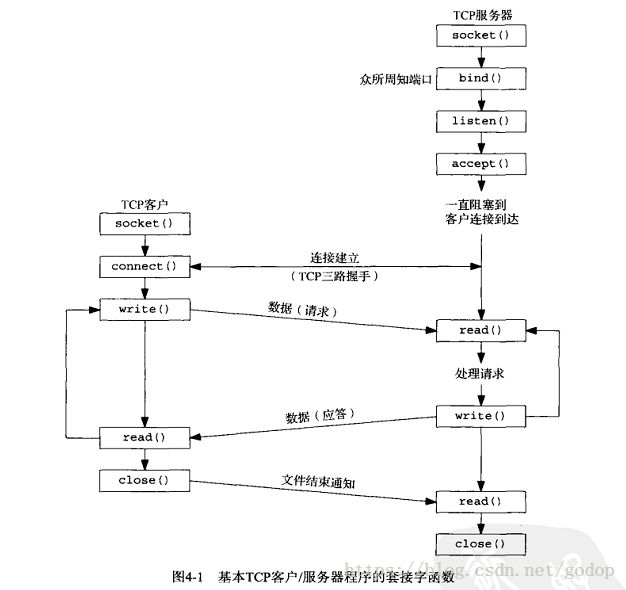1、网络基础
基本TCP客户-服务器程序Socket编程流程如如下图所示。
TCP服务器绑定到特定端口并阻塞监听客户端端连接,
TCP客户端则通过IP+端口向服务器发起请求,客户-服务器建立连接之后就能开始进行数据传输。
Golang的TCP编程也是基于上述流程的。
2、Golang HTTP编程
2.1 代码示例
func timeHandler(w http.ResponseWriter, r *http.Request) {
fmt.Fprintf(w, "%v", time.Now().Format(time.RFC3339))
}
func helloHandler(w http.ResponseWriter, r *http.Request) {
fmt.Fprintf(w, "%v", "hello world.")
}
func main() {
// 1. 新建路由解码器
h := http.NewServeMux()
// 2. 路由注册
h.HandleFunc("/hello", helloHandler)
h.HandleFunc("/time", timeHandler)
// 3. 服务启动 阻塞监听
http.ListenAndServe(":8000", h)
}
运行上述程序,在浏览器地址栏分别输入 http://localhost:8000/hello http://localhost:8000/time 结果分别如下图所示。
2.2 源码分析
分析从路由注册到响应用户请求的流程。
2.2.1 新建解码器 h := http.NewServeMux()
type ServeMux struct {
mu sync.RWMutex
m map[string]muxEntry
es []muxEntry // slice of entries sorted from longest to shortest.
hosts bool // whether any patterns contain hostnames
}
type muxEntry struct {
h Handler
pattern string
}
// NewServeMux allocates and returns a new ServeMux.
func NewServeMux() *ServeMux { return new(ServeMux) }
Handler是interface,定义如下
type Handler interface {
ServeHTTP(ResponseWriter, *Request)
}
ServeMux实现了Handler接口。
2.2.2 路由注册 h.HandleFunc("/hello", helloHandler)
// HandleFunc registers the handler function for the given pattern.
func (mux *ServeMux) HandleFunc(pattern string, handler func(ResponseWriter, *Request)) {
...
mux.Handle(pattern, HandlerFunc(handler))
}
func (mux *ServeMux) Handle(pattern string, handler Handler) {
...
e := muxEntry{h: handler, pattern: pattern}
mux.m[pattern] = e
if pattern[len(pattern)-1] == '/' {
mux.es = appendSorted(mux.es, e)
}
...
}
timeHandler和helloHandler函数被强制转换为type HandlerFunc func(ResponseWriter, *Request)类型,且实现了Handler接口。
func (f HandlerFunc) ServeHTTP(w ResponseWriter, r *Request) {
f(w, r)
}
mux.m建立了路由到处理函数timeHandler和helloHandler的映射。
2.2.3 服务启动阻塞监听 http.ListenAndServe(":8000", h)
包装Server结构体,HTTP使用TCP协议。
func ListenAndServe(addr string, handler Handler) error {
server := &Server{Addr: addr, Handler: handler}
return server.ListenAndServe()
}
func (srv *Server) ListenAndServe() error {
...
ln, err := net.Listen("tcp", addr)
if err != nil {
return err
}
return srv.Serve(ln)
}
net.Listen封装了Socket编程的socket,bind,listen的调用,极大的方便了使用者。
阻塞监听请求,新建goroutine处理每个新请求。
func (srv *Server) Serve(l net.Listener) error {
...
for {
rw, err := l.Accept()
...
c := srv.newConn(rw)
c.setState(c.rwc, StateNew, runHooks) // before Serve can return
go c.serve(connCtx)
}
}
// Serve a new connection.
func (c *conn) serve(ctx context.Context) {
...
serverHandler{c.server}.ServeHTTP(w, w.req)
...
}
func (sh serverHandler) ServeHTTP(rw ResponseWriter, req *Request) {
handler := sh.srv.Handler
...
handler.ServeHTTP(rw, req)
}
通过前面的流程推导可知,handler是http.ListenAndServe的第二个参数ServeMux
// ServeHTTP dispatches the request to the handler whose
// pattern most closely matches the request URL.
func (mux *ServeMux) ServeHTTP(w ResponseWriter, r *Request) {
...
h, _ := mux.Handler(r) // 通过路由获取处理函数
h.ServeHTTP(w, r)
}
mux.Handler使用mux.m这个map通过请求URL找到对应处理函数的。
h的实际类型为HandlerFunc,根据2.2.2会调用到具体函数timeHandler或者helloHandler。
3. 总结
golang对socket编程进行了封装,给HTTP编程带来了极大的便利。
但是不支持以下特性
1. 路由分组 对路由进行分组,可以方便分组鉴权
2. 动态路由 如动态路由/user/:username/post/:postid不支持
以上就是Golang HTTP编程的源码解析详解的详细内容,更多关于Golang HTTP编程的资料请关注脚本之家其它相关文章!


